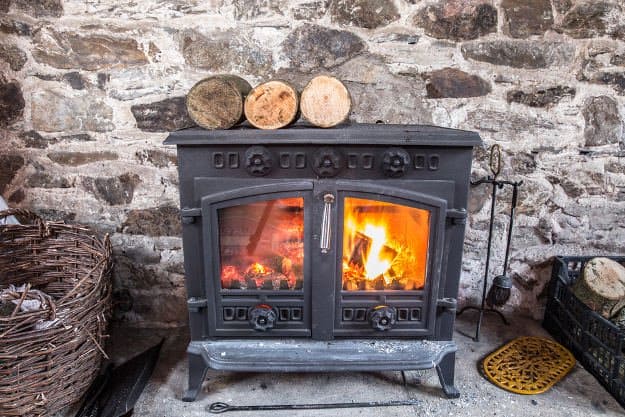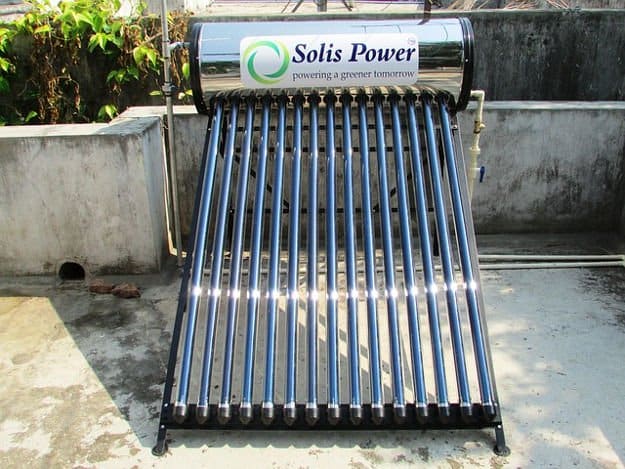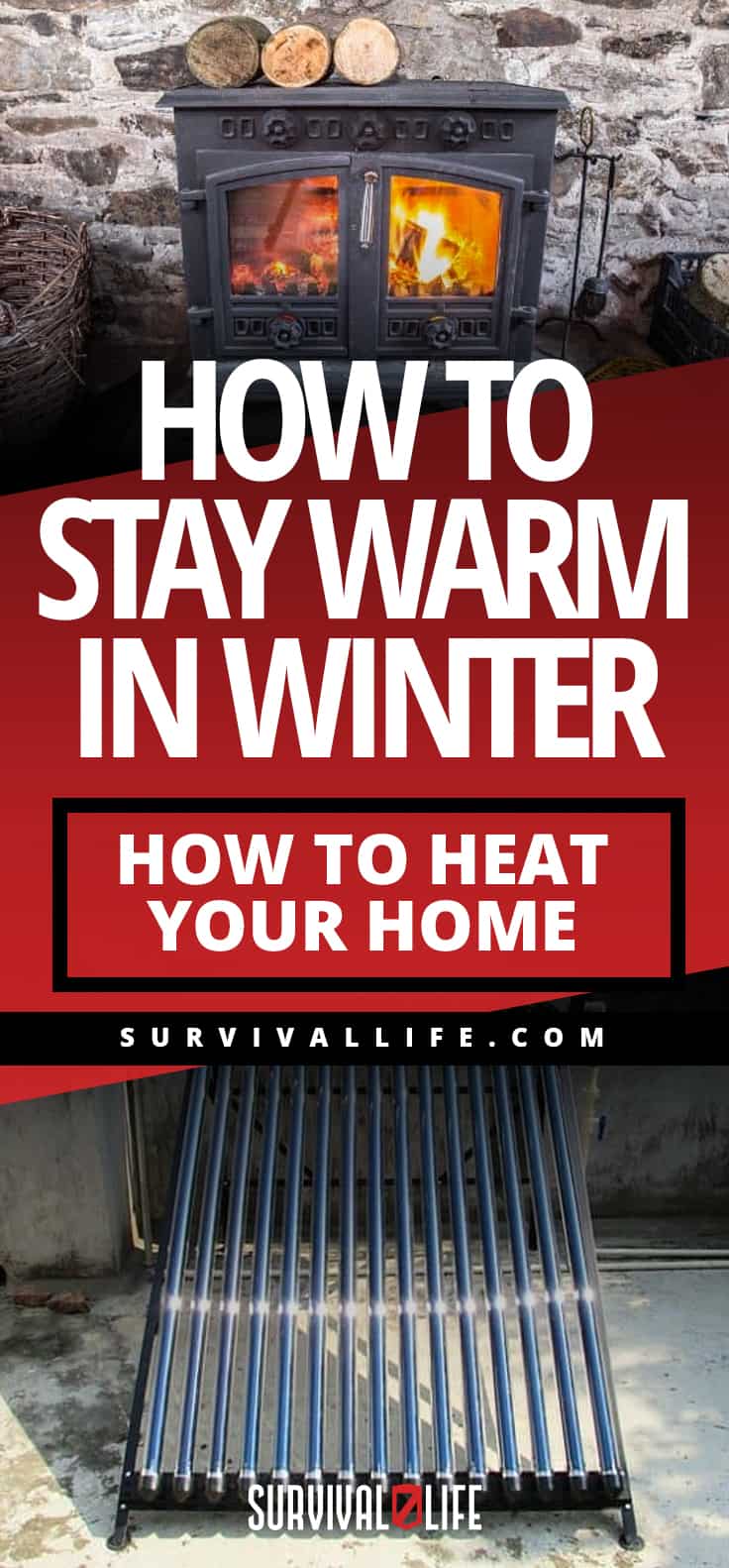Winter Survival
How To Stay Warm In Winter | How To Heat Your Home
You probably have it all set up for the cold season with your winter air condition system. The question is..How can you keep the heat in your home in winter during a power outage? Check out these tips to keep your home nice and warm.

How to stay warm in winter? Here are survival tips to keep your home warm without the need for electric power.
RELATED: Outdoor Survival | 13 Winter Camping Tips For Every Survivalist
7 Survival Life Tips on How to Stay Warm In Winter
Winter Preparedness
Preparedness is crucial especially in winter, so you have to be ready for the possibility of not being able to utilize your air heaters. Some houses can cope with different weather conditions, but the cold can be too much to handle.
It's essential to learn other ways to stay warm in the winter in case there's no electricity, or much worse, at an extended period of time.
When staying warm or at least maintaining a comfortable temperature in your home, there are a number of things you can do without power from the grid.
First is the initial design and layout of the home, the immediate actions when the power goes out, and the survival actions when the power outage drags on.
Always consider the worst possible scenario and know how to remedy the situation. The most important thing for your home in winter is to have a manageable temperature for your body to get through the cold season.
Initial Design and Layout
Homes designed for warmth have the majority of windows facing south. Some home builders back up the north side of the house in a slope to prevent heat loss and increase connection with the earth.
Study old photos or paintings of Northern Europe during the Renaissance Period. Notice how they dressed, how their buildings were furnished including the heavy fabric murals, and how thick the doors and walls were.
What is the Renaissance Period? Called the rebirth of the Middle Ages, it covers fourteenth to seventeenth centuries.
It shows how early pioneers constructed a shelter out of naturally-occurring material such as wood logs, strips of thick sod, and adobe bricks. You can use almost anything to create a warm dwelling – even ice.
The homes of the early settlers were usually comfortable in both summer and winter. They knew how to construct and use their dwellings to enhance human comfort. So can you.
Stay Warm with Wood Stoves and Fireplaces

In Upper Canada or the rural areas of the U.S. north, most people use a fireplace or wood stove to heat their homes and stay warm. Eighty years ago, our parents and grandparents burned coal in furnaces.
Today, many people use electric furnaces — risky if power is prone to be lost. Just ask the thousands of people in North Carolina who suffered greatly when their electrical power went out for weeks last winter.
Fireplace inserts are the rage in the Upper Midwest. Wood is still plentiful in many areas and the use of FP inserts is worth investigating.
A few logs in one of these stoves can keep a room quite comfortable and let you stay warm all night. Intelligent use of slow-speed fans can move warm air into areas that are still too cool (or cold) for comfort.
You can install a wood burning stove to back up your furnace. If you use a natural gas or kerosene stove, remember that these must be vented properly to prevent carbon monoxide buildup.
Stay Warm with the Power of the Environment
The key is to use the environment around you – including daylight. Use the sun wherever and whenever you can.
It’s a great resource. Use sunlight shining in windows and doors to warm rooms and patios.
If you can, use the sun to generate solar power that can operate electric heaters. And don’t forget the smart use of emergency portable generators — gas, propane, or solar.
Passive solar heating works. Check this out, too.
I recall a blog poster describing framed boxes with black tar paper (black asphalt roofing paper) inside and plexiglass on the face being mounted on the south walls of cottages on the East Coast.
Vents were cut through the top and bottom of the cottage walls to allow air flow from the thermal box into the cottage.
RELATED: Winter Survival | What To Do When The Heat Goes Out
Solar Heaters
Water heated by the sun can also generate warm heat. Solar heaters work.
Allowing the sun to heat water in the dark piping can heat the liquid to bath temperatures or hotter. The water from this solar collector can then be pumped through convection radiators that emit heat out into rooms and into hot water tanks for showers and baths.

Some people close off rooms in their home every winter, reducing their living space to less cubic feet of air to heat. I met an Amish family who did this every winter.
They used quilts to cover doors to rooms they wouldn’t be using during the cold weather. This worked quite well.
Other homeowners install storm windows and storm doors for keeping warm and the cold out. And they upgrade the insulation in their attics and walls. I don’t think you can ever over-insulate.
Staying Warm in a Nighttime Power Outage
If the power goes out and your furnace shuts down on a cold night, act quickly to retain as much heat as you can. Insulate and isolate. These actions could include:
- Close all window coverings (drapes, blinds, shades, etc.).
- Shut doors to all rooms that are not being used or needed.
- Create a zone within a zone. Cover your sleeping area with insulated fabric.
- Place draft stoppers at the base of all exterior doors.
- Start a backup heat source (fireplace, kerosene or propane heater, etc.).
- Layer up to keep your body warm as the house cools.
- Staple emergency solar blankets to drafty doors and windows (shiny side in).
- Activate a solar heater.
Staying Warm in a Daytime Power Outage
If the power goes out during the day isolate and insulates as above, but open drapes covering windows bathed in sunlight so you can capture the solar heat.
I read about a blog poster who placed black plastic on the floor below the window and let the sun heat the plastic to add warm air to the room.
Some rooms have dark tile or cement floors that absorb heat, then releasing it after the sun goes down. Sunlight on this dark surface causes the material to absorb energy and heat up.
Once the sun goes down, the stored heat radiates up off the floor. You can also close insulated drapes to keep this heat inside.
Watch this video by the Home Depot about getting your fireplace ready for the winter:
https://www.youtube.com/watch?v=W9QbzzYZmbg
These are the different approach for you to remember to winterize your home. But still, no matter how winter-proof your house is, always prepare yourself as things can easily get out of hand in winter and it may force you to outlast a survival situation.
What other ways do you know to stay warm in the winter? Share them with us in the comments section below!
Up Next:
- Winter Storm Survival: How to Stay Warm and Survive the Cold
- The Prepper’s Guide to Winter Survival
- Desert Survival | How To Make A Shelter That Can Take The Heat

Editor’s Note: This post was originally published in December 2016 and has been updated for quality and relevancy.
-

 Paracord Projects1 year ago
Paracord Projects1 year agoParacord Projects | 36 Cool Paracord Ideas For Your Paracord Survival Projects
-

 Paracord Projects1 year ago
Paracord Projects1 year agoHow To Make Paracord Survival Bracelets | DIY Survival Prepping
-

 Medical Care1 year ago
Medical Care1 year ago21 Home Remedies For Toothache Pain Relief
-

 Knife Laws1 year ago
Knife Laws1 year agoAre Switchblades Legal? Knife Laws By State
-

 Do It Yourself1 year ago
Do It Yourself1 year agoSurvival DIY: How To Melt Aluminum Cans For Casting







Pingback: Stay Warm in the Winter | How to Heat Your Home | Survivalist Basics | Be Prepared For Anything!
Pingback: Stay Warm in the Winter | How to Heat Your Home | Patriot Powered News
Trish
November 15, 2014 at 11:01 AM
One of the first things we invested in when we bought our 56-year-old house was insulated double paned windows. The original windows were drafty and most storm windows were missing. This had the advantage of not heating or air conditioning the outdoors. It also made the house quieter.
Second item was a programmable thermostat. It made little sense heating or air conditioning to our comfort when we were at work all day.
We hired a fireplace expert to clean chimney and talked to him about an insert with a fan. He refused to install one. He said retro-fitting one is dangerous.
Another possibility during power outage is to move to basement if you have one. Basements tend to change temperature less than upper floors.
I also collect quilts. It’s amazing how well even a cheap quilt can keep you warm at night. Stack them up and we’re snug.
Additionally, growing up in snow country where we had blizzards, one of my earliest lessons was to share body heat. It doesn’t matter if you know or like the person with you, snuggle and you’ll both stay warm.
John K
November 15, 2014 at 11:10 AM
Another alternative heating source is simple tea candles and flower pots. Here’s one instructable on how to do it: http://www.instructables.com/id/Flower-Pots-Tea-Lights-Heater.
Allan P Brown
November 9, 2018 at 8:04 AM
There are some safety concerns that go along with the tea candle and flower pot device.
There are only so many BTUs in a tea candle. When the candle burns they all come out and turn into heat and light. A tea candle in a glass jar is just as effective as a heater as a flower pot heater that on occasion have been known to overheat and flash. I keep a few tea candles in my go bag and can make a cup of tea, coffee or bouillon in an emergency. Or start a fire when the local week is too damp.
chris
November 15, 2014 at 12:48 PM
Start using the infra red heaters like the eden pure heaters. There are several places making them now and they are a lot cheaper too. I like how these heaters heat the whole room from top to bottom. They also don’t dry out the air like regular electric heaters do. I put my main heat on lower and let the infra red heater take care of the rest now. My electric bill is a lot cheaper. I would use these new heaters with my fireplace or wood burner going too as long as the electric was on.
Ted
November 15, 2014 at 12:50 PM
You only need a key. Key Largo would work.
buz davis
November 15, 2014 at 1:22 PM
Lots of blankets, and many cate. In addition to being such
splendid animals on a cold night they are like hot-water bottles!
buz davis
November 15, 2014 at 1:23 PM
for “cate” read “cats”.
Pat Gloska
November 15, 2014 at 6:27 PM
Ok, so here’s one for you, I live in an RV. I use window plastic & solar heating. Main heat is propane with an assist from electric heaters. Any other ideas??
Cat
November 18, 2014 at 10:15 AM
I live in an RV as well. I bought some window panel drapes made of insulating fabric at Walmart, and cut them up to make curtains for all my windows. I find it makes a difference. The door is an area where heat escapes: I use foam weatherstripping around it and also made a full-length curtain of insulating fabric hanging in front of the door. Also I’ve insulated the inside of the door with a layer of 3″ fiberglass (with a removable cutout for the window). All this helps with keeping cool in summer as well. Since I’ve replaced the original carpet with vinyl tile, I now put some thick throw rugs on the floor in winter. Of course I “let the sunshine in” when it is shining, and am oriented so that I get sun all day in the winter, which helps a lot. My heat source is propane, but I’m looking into getting one of those mini woodstoves I’ve read about on “tiny house” blogs, in case propane should be unavailable. It would need to be properly vented, etc. but we RV folk are a creative lot!
Duane Williams
November 13, 2016 at 2:50 PM
A gallon bottle of hot water, will stay fairly hot most of the night, close a bedroom door for keeping heat, BUT…can put a Hot Hands under the bottle…it heats to 140 and lasts 8-12 hours, so hot all night…THOUGH…expensive!! If we could DIY them! Another hand warmer, can DIY They get to about 90 degrees, have a disk of metal you click to activate, but by boiling them afterwards, can be used over and over hundreds of times…
Cheyenne
November 15, 2014 at 8:04 PM
Put on a pair of socks, in a second pair lightly Sprinkle CAYENNE PEPPER, shake the, add over the ones you’re wearing will keep you toasty.
If you don’t have carpeted floors, layer newspapers under bed. On the top mattress layer (at least 3), add fitted sheet, two layers of paper & 1 more fitted sheet, then the rest of your bedding. YES it Will be crinkly the first few days, it Will make a difference.
Windows you don’t need to see out, cover in bubble wrap.
Use painters tape, go across bottom top& sides of windows, this will insure windows won’t leak in cold air.
Those are a few I learned when circumstances had me living w/o Any utilities for 8 yrs in the middle of modern society.
Helicopter
November 15, 2014 at 8:14 PM
Place an emergency blanket between the mattress and box spring (shiny side up). Heat lost through the mattress is reflected back up.
Black Rifle
November 20, 2014 at 4:49 PM
Sounds like a good idea. Does it really work?
Duane Williams
November 13, 2016 at 2:53 PM
But—a Mylar blanket is like an electric blanket set on high and you will cook in the long run!!
cmac
November 16, 2014 at 1:35 AM
While I do not have a link or source handy I have read articles on using clay flowerpots and votive candles to heat a small space. Basically you need two clay pots one larger than the other, a shallow pan that they will sit on, and votive candles. If I remember correctly you put the votive candles in the shallow pan and light them, place the smaller pot on the edge of the bottom pan over the candles with the drain hole plugged then place the larger pot over that.
cmac
November 16, 2014 at 1:36 AM
Look up heating a room with votive candles and clay flower pots.
flyovercindy
November 16, 2014 at 6:53 PM
I’ve collected my correctly sized flower pots, cast-off metal pans and lots of votives and wax for candles. Haven’t tried these little heaters yet, but I’ve heard that they kick out quite a bit of heat – looking forward to trying it!
Danny Clark
November 18, 2014 at 9:41 AM
We have a Kerosene Heater as back up. During our last ice storm we lost power for several days. We had Kerosene but not more than a few days worth. Kerosene will disappear pretty quick in emergency situations, but something for readers to remember is that Kerosene is a jet fuel, and most airports will sell it to you in emergency situations. Now I keep at least 25 gallons on hand. You average about 13-18 hours of heat depending on how you set yourKerosene heater on. Remember to only heat the rooms you need to heat and it can last even longer. Also there are different ways you can use candles not only for light but for heat too. I had complained to my wife about her keeping a box of 30-40 candles around until our ice storm. Not anymore! I increased it to 3 boxes of 50 candles each. Too too useful! Might want to share how you can make heaters with ceramic plant holders and candles?
Walt
November 18, 2014 at 10:00 AM
I live in Michigan and am looking for reliable advise on upgrading my wood burner. Can I get your brother’s contact information?
Robert Brenner
November 18, 2014 at 9:51 PM
Google Mr. Chimney Sweep, St. Clair County. Be advised that he is scheduled for work until mid January.
Jack Daniels
November 18, 2014 at 10:24 AM
I crawl under my bison hide on coldest nights, count to 10 or 15 and bare feet are warm.
Jack Daniels
November 18, 2014 at 10:32 AM
On the coldest nights, I crawl under my bison hide, count to 10 or 15 and my bare feet are warm and toasty.
Duane Williams
November 13, 2016 at 2:55 PM
But….if it’s 10 below in the AM how do you get up?
Gael Conklin
November 18, 2014 at 10:35 AM
I haven’t read all the comments, so I don’t know if anyone has added this….there are eight in my house…we have two smaller (3 or 4 person) pop up tents….throw them on the floor in the basement…4 per tent…..BODY HEAT!
Satire Works
November 18, 2014 at 1:20 PM
If you have a large window that needs a better seal, pick up a clear shower curtain ($5-$6) from Walmart or even less at a “dollar store” or flea market. Use some foam tape and furring strips to attach and seal it to the outside of your home. You can still see through it and you can still get the sun’s heat indoors. You’ll repay the cost many times over during Winter months.
Do you have a sun room or greenhouse attached to the home? Place many milk jugs or 5 gal. pales filled with water or (black-painted) cinder blocks in the space. During the day the sun will warm them. An opened door (6′ slider is best) to the area during the day can continue to gain warmth late into the afternoon. Don’t want to leave a door open when you are not at home? Cut a thermostatically controlled vent with a fan at a high point (over the door or just in a wall).
Doing some wash? Time things to run your dryer in the evening or just before bed.
S Barringer
November 18, 2014 at 1:59 PM
We had an electrical outage this last winter. My power was out for 10 days. I had a chance to practice for real how to heat this particular house. I use kerosene heaters and propane heater rated for indoor use. So, power out here; no problem. The one item I need to add is a generator to run the sump pump in the basement and the freezer. Also, I have a good supply of blankets since the heaters need to be turned off at night unless you have someone to attend to them. This is when it is nice to have 2 or more people living in the house. Household chores become much more labor intensive when the grid is out. Good luck to everyone. That day is coming when fuel of all kinds will be hard to get. BTW, if you plan on living off the grid all the time, don’t buy a house with a sump pump in the basement.
da
November 18, 2014 at 5:33 PM
In an emergency, why not set-up a tent inside your home? Best would be one or more self-supporting two or three person tents. You can at least sleep or relax in it, and body heat will keep it fairly warm. You could also set-up blanket tents using tables and chairs.
Pingback: Winter Storms | How to Stay Warm and Survive - Survival Life | Preppers | Survival Gear | Blog
Pingback: Winter Storms | How to Stay Warm and Survive | Survivalist Basics | Be Prepared For Anything!
Pingback: Winter Storms | How to Stay Warm and Survive | Prepper News
Pingback: Winter Storms | How to Stay Warm and Survive | Home Preppers
David Caisse
February 5, 2015 at 11:26 PM
I had read somewhere that you can make heaters out of a meatloaf pan a tea lite candle 2 bricks and a clay pot! Those ingredients are supposed to make a small but hot furnace! Put the bricks in the pan, lite the small candle and put the clay pot upside-down. Very hot air is supposed to come out through the hole in the bottom of the clay pot! Have you heard of this or tried it?. Regards, Dave
Pingback: 13 Ways to Build A Badass Man Cave For The Ultimate Escape
Pingback: Winter Survival Tips: How to Stay Warm and Survive a Winter Storm
Pingback: Winter Storm Survival: How to Stay Warm and Survive the Cold | Survival Life
Pingback: Is This Simple Survival Tool a Cure For the Cold Weather Blues?
samnjoeysgrama
December 2, 2016 at 10:33 AM
What a great article!!! One simple thing to do, which our grandparents would be shocked that we don’t do, is wear long underwear. I live at 8500 ft in the Rockies and my 70 yr old friend who grew up here says the coldest she remembers was 58 below zero. Wearing warmer clothing inside is just common sense, but many don’t do it. If you have little ones, the two piece pajamas that look like long johns work well under their clothes as underwear.
I live in an 1870 log cabin and I insulated thoroughly when I renovated. Even so, I still put heat shrink, clear plastic film on the North facing windows. They are new double pane windows, but just the glass loses heat. It doesn’t show at all and it makes a major difference. Insulated drapes you close at night also help dramatically.
My adult son has an attachment on his iPhone that takes an infrared picture that shows any spots where you may be losing heat. It’s brilliant. Electrical outlets are big culprits and easy to insulate with the foam sold at hardware stores.
If you have a newer gas or propane stove with an electric “pilot”, you can still turn it on and use it with a match.
I live on 100 acres, and I’m 67. Splitting firewood isn’t my thing. I found a local guy who sells firewood and I trade him a full pickup of dead logs from my property for +/-1/4 pickup of split firewood. Nice guy and we both win.
Be careful stacking your firewood and don’t put it up against the side of the house, however convenient. With drought and wildfire in many areas, you are just providing fuel to help get a good house fire going. Talk to your local fire department about “defensible space”.
Finally, get a Carbon Monoxide detector with a battery backup and put it at lower than knee level. Smoke rises. Carbon Monoxide sinksl. A smoke detector on the ceiling with a CO detector is useless for the CO. My wonderful, 40 yr old doctor died a few years ago from Carbon Monoxide poisoning when he came to his mountain cabin for the weekend. This can happen from a bad gas furnace, but is all too common in power outages when people try to heat with anything available. Don’t be a statistic.
Again, great article! Stay safe and warm preppers.
Pingback: 13 Winter Survival Methods To Keep You Warm - Survive!
Pingback: 13 Winter Survival Methods To Keep You Warm | Survival Life
Pingback: How To Stay Warm In Winter | How To Heat Your Home
Pingback: How To Stay Warm In Winter | How To Heat Your Home | Life Off The Grid
Anne Meeker
November 10, 2018 at 10:30 AM
The articles were great but what if you just rent? Worse yet, I rent a mobile home. What can I do to stay warm? I’m an older woman, live alone and need ideas. I have insulated drapes that I close as the sun goes down, close off rooms that I don’t use, wear layers of clothing and I put plastic on windows. I put the strips of foam insulation all around doors that lead to the outside also. What else can I do that is going to be cost effective? My income is limited so I need inexpensive ideas. One more thing, due to health reasons, I need to be warm- I should move to a warmer climate but that’s not possible, please tell me what else I can do. Thank you, I appreciate any thoughts and ideas you may have.
Maggie Medina
November 11, 2018 at 6:41 PM
I live in an old wood cabin, on a hundred acres. Hate getting up in the middle of the night to put wood in the fireplace, sometimes it goes out in the middle of the night. So I use this method often. Got 10 1-gallon jugs of water. Painted the jugs black on the outside. Set the jugs on a dark piece of wood, blanket, or black painted cardboard with the sun shining on them. They absorb an incredible amount of heat. Got an old fashioned hot water bottle, and filled with some of that hot water. Makes for a very warm bed. I take the jugs and put inside a tent In my living room. Put my twin mattress inside, with a surplus military wool blanket covered with a fleece blanket on the mattress, and fleece blanket on top. Most nights, I go to bed at 10pm, wake at 6, sleep thru the night, toasty warm. The next day put the jugs back out, and warm them again. Usually only use my heater or fireplace when temp drops below zero, or no sun to warm water. Am adding wood stove this spring to keep hot water 24/7. Hope this helps.
Jan Craig
November 18, 2018 at 10:13 AM
I live in an un-insulated 1905 farm house…enough said. For heat, I have a propane box heater (that I can sit on when on low which is most of the time) and a wood stove. At 71, I found my feet getting cold from the cold floor. The best Sorel slippers…feet still cold. I found a new pair of the dark blue wool liners ($ 10 +/-) I use in my rubber boots. Pulled out the insoles of my slippers, slipped in the wool liners and put the original insoles back in. My feet have never been so toasty and it really helped my body heat too. Those and a cute little winter hat have made winter much better. And I do plastic the windows and the like, but by keeping your head and feet warm you go a long way towards comfort.
Maggie Medina
November 11, 2018 at 7:09 PM
When I first moved into my cabin, it had no heat, only wood fireplace. The first year, I went thru so much wood, I knew there was no way I could cut enough to keep up the next winter. I decided to make some solar heaters, and vent into the living room. I collected a bunch of aluminum cans, painted them black, siliconed 8 cans high x 6
cans wide. Then I stacked them in a frame made of wood, with a mylar blanket on the wood backboard. I cut a hole for a dryer vent hose on the top of the frame, and vented into the house. Put a piece of glass over it, Siliconed the glass cover in place. Made sure it had sun at least 6 hours of sun during the day. Most good days, the thermometer inside the box reads between 130 to 150 degrees. The rising heat vents into the house thru a heavily insulated dryer vent hose. The cabin stays a good 68 to 72 during the day. I have 1 on the East side of the cabin, and one on the South. Works great. All materials in total less than 100 bucks including salvaged glass from junk yard.
Pingback: Winter Storm Survival: How to Stay Warm and Survive | Survival Life
Pingback: Winter Storm Survival: How to Stay Warm and Survive the Cold | Primitive technology
Pingback: Winter Storm Survival: How to Stay Warm and Survive the Cold
Pingback: 3 Easy Ways To Make Homemade Waterproof Matches | Survival Life
Pingback: 3 Easy Ways To Make Homemade Waterproof Matches – Ultimate Survival Alerts
Pingback: 5 Venomous Snakes and Their Look-Alikes | Survival Life
Pingback: 13 Winter Survival Methods To Keep You Warm - Les Recettes Savoureuses
Pingback: 13 Winter Survival Methods To Keep You Warm - Primal Survival